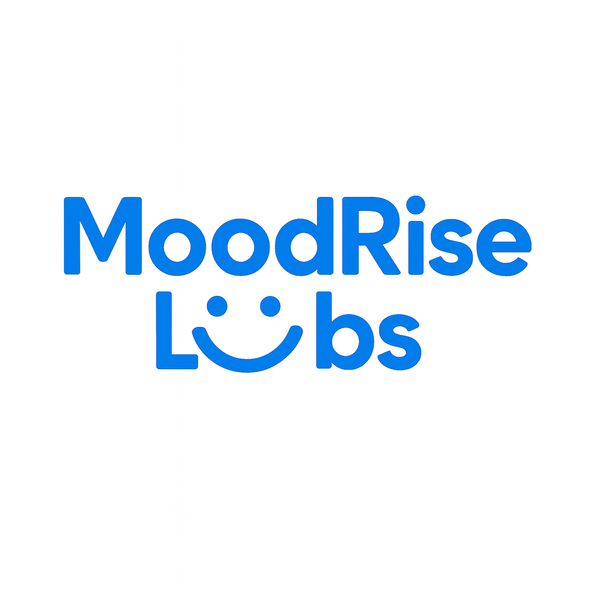The Role of Neurotransmitters in BDD—and How Supplements May Help
Introduction
When you live with Body Dysmorphic Disorder (BDD), your relationship with your reflection can feel like a battle. No matter how many people reassure you that you look fine, your mind insists something is wrong — that flaw, that shape, that imperfection. But this isn’t vanity; it’s neurobiology.
Behind the anxiety, compulsive checking, and distorted self-image lies a profound neurochemical imbalance. Your brain’s neurotransmitters — the messengers that regulate perception, emotion, and reward — are misfiring. They distort how you process visual and emotional information, making your body appear different from reality.
In this article, we’ll explore how neurotransmitters like serotonin, dopamine, glutamate, and GABA shape the experience of BDD, and how targeted nutritional and herbal supplements may help restore balance, calm obsessive thoughts, and support healing from within.
Looking for supplements for This? Click here.
The Brain Behind the Mirror 🪞
The human brain doesn’t see the body as it truly is — it interprets it. Every time you look at yourself, your brain’s visual cortex processes the details and your limbic system (emotional center) assigns meaning to what you see.
In people with BDD, this system goes haywire. Instead of perceiving the body as a whole, the brain fixates on microscopic details. A small asymmetry becomes monstrous. A normal feature becomes unbearable.
Neuroimaging studies show that people with BDD overactivate the left hemisphere (detail-oriented visual processing) and underactivate the right hemisphere (holistic visual integration). This imbalance is magnified by chemical dysregulation — especially in serotonin and dopamine pathways.
The result is a mind caught in a loop: distorted perception → anxiety → compulsive checking → temporary relief → back to anxiety.
Breaking that loop requires stabilizing both thought patterns and brain chemistry.
Serotonin: The Balance Chemical 🌸
Serotonin is often described as the brain’s “feel-good” chemical, but in BDD it’s more accurately the “balance” chemical — regulating mood, perception, and sensory filtering.
Low serotonin means the brain’s “filter” malfunctions. Neutral sensations (like seeing your reflection) can feel threatening or emotionally charged.
This imbalance explains why people with BDD often report intense anxiety when looking in mirrors or photos — their brains process self-image through a lens of alarm rather than neutrality.
How Serotonin Affects BDD
Serotonin helps the brain tune out unimportant stimuli. When levels drop, hyperfocus emerges — especially on physical details. It also regulates the prefrontal cortex, the part of the brain responsible for rational perspective.
Without enough serotonin, emotional and cognitive regulation weaken. Thoughts spiral faster, and reassurance feels temporary.
Supporting Serotonin Naturally 🌿
While SSRIs (selective serotonin reuptake inhibitors) are a medical standard for BDD, some people also use nutritional strategies to support serotonin pathways naturally:
5-HTP (5-hydroxytryptophan): a direct serotonin precursor that may enhance mood and calm obsessive thinking.
Vitamin B6: a cofactor in serotonin synthesis — without it, 5-HTP can’t convert efficiently.
Magnesium glycinate: reduces cortisol, stabilizing serotonin signaling.
Omega-3 fatty acids (EPA/DHA): improve serotonin receptor fluidity and function.
Together, these nutrients support the biological terrain that serotonin needs to thrive — allowing the emotional brain to quiet down.
Dopamine: The Obsession Driver ⚡
If serotonin is about calm balance, dopamine is about reward and focus. It motivates behavior — but when it’s dysregulated, it can trap the mind in obsessive loops.
In BDD, dopamine imbalances are thought to drive the compulsive checking, comparing, and reassurance-seeking behaviors. Every mirror glance or cosmetic fix momentarily boosts dopamine — but the relief fades quickly, creating dependency on the behavior.
This “dopamine rollercoaster” mirrors the reward pattern seen in OCD and addiction. The brain learns that checking = relief, even though the relief reinforces anxiety long-term.
The Neurobiology of Dopamine and BDD
BDD often involves overactivity in frontostriatal circuits — regions connecting the prefrontal cortex (logic) and the basal ganglia (habit/reward).
When dopamine spikes erratically, these circuits amplify repetitive thoughts. The logical brain knows the flaw isn’t real, but the reward circuit insists it must be fixed.
Supporting Dopamine Balance 🧠
Healthy dopamine doesn’t mean more dopamine — it means regulated dopamine. Supplements that stabilize rather than stimulate can help:
N-Acetyl L-Tyrosine (NALT): supports steady dopamine production during stress without overstimulation.
Rhodiola rosea: an adaptogen that normalizes dopamine and serotonin levels simultaneously, improving focus without obsession.
L-theanine: increases dopamine while also promoting GABA calm, creating mental clarity without anxiety.
CoQ10 and B vitamins: support mitochondrial function for smoother neurotransmitter release.
When dopamine flows steadily, motivation and focus remain — but compulsion fades.
Glutamate: The Overdrive Neurotransmitter 🔥
Glutamate is the brain’s main excitatory neurotransmitter — it activates neurons and keeps you alert. But too much glutamate is like too much caffeine for your brain: overstimulation, tension, and racing thoughts.
In BDD, glutamate dysregulation appears to play a role in the intrusive thought cycles and sensory overload that make reflection or social exposure so painful.
High glutamate means the brain fires too rapidly, especially in regions tied to visual processing and self-perception. This explains why individuals with BDD often report mental noise, visual distortions, and difficulty shifting focus away from body concerns.
Supporting Glutamate–GABA Balance ⚖️
Your brain maintains calm by balancing glutamate with GABA, its inhibitory counterpart. Too little GABA or too much glutamate equals mental chaos.
Nutrients that help restore this balance include:
Magnesium threonate: crosses the blood-brain barrier, helping regulate glutamate signaling and enhance neuroplasticity.
Taurine: increases GABA activity and reduces glutamate overstimulation.
N-acetylcysteine (NAC): modulates glutamate and oxidative stress, improving cognitive flexibility and emotional regulation.
Studies on NAC have shown promise in reducing repetitive behaviors in OCD — a finding with strong implications for BDD as well.
Looking for supplements for This? Click here.
GABA: The Brain’s Brake Pedal 🧘

If glutamate is the accelerator, GABA is the brake. It slows neural activity, promotes relaxation, and prevents emotional overwhelm.
Low GABA is linked to anxiety, racing thoughts, muscle tension, and sleep issues — all common in BDD.
Because people with BDD live in a near-constant state of hyperarousal (fight-or-flight), their GABA levels often run low. This makes it difficult to experience peace or mental quiet.
Supporting GABA Naturally 🌙
Some supplements can gently support GABA pathways without dependency:
L-theanine: increases alpha brain waves, promoting GABA calm while maintaining alertness.
Magnesium glycinate: enhances GABA receptor sensitivity.
GABA or PharmaGABA: direct supplementation can help short-term relaxation, especially before sleep or high-anxiety situations.
Chamomile extract: contains apigenin, a natural GABA agonist that reduces stress without sedation.
Restoring GABA tone is like teaching the brain how to exhale again — essential for breaking the chronic tension that drives appearance anxiety.
The Stress Hormone Connection: Cortisol and the HPA Axis 🌡️
Neurotransmitters don’t work in isolation — they interact with hormones, especially cortisol, the body’s main stress signal.
In BDD, constant body-related anxiety keeps the HPA axis (hypothalamic–pituitary–adrenal system) overactive. Cortisol floods the bloodstream, creating chronic inflammation and neurotransmitter depletion.
Elevated cortisol lowers serotonin, overstimulates dopamine, and destabilizes glutamate–GABA balance — reinforcing obsessive, anxious states.
Adaptogens for Cortisol Balance 🌿
Adaptogenic herbs help your body adapt to stress by balancing cortisol output.
Ashwagandha lowers cortisol while improving serotonin and dopamine balance.
Holy basil (Tulsi) calms the stress response and reduces rumination.
Rhodiola rosea supports endurance and emotional resilience under pressure.
Over time, adaptogens retrain the stress system — so triggers no longer send the mind into panic.
The Gut–Brain Axis and Neurotransmitters 🦠
Serotonin and dopamine aren’t just made in the brain — they’re also produced in the gut. About 90% of serotonin originates in the digestive tract.
This means gut inflammation, dysbiosis, or nutrient deficiency can directly worsen BDD symptoms by disturbing neurotransmitter production.
Supporting gut health through probiotics, prebiotics, and anti-inflammatory nutrition helps restore serotonin and dopamine homeostasis naturally.
Fermented foods (yogurt, kefir, kimchi) boost beneficial bacteria.
Fiber from fruits and vegetables feeds those bacteria.
Omega-3s reduce gut inflammation that disrupts neurotransmitter synthesis.
When the gut feels safe, the brain begins to calm.
Nutrients That Support Overall Neurotransmitter Harmony 🌿🧠
Beyond specific neurotransmitters, several nutrients nourish the brain’s chemical ecosystem as a whole:
Zinc: cofactor in dopamine metabolism and neuroplasticity.
Iron: necessary for serotonin and dopamine synthesis; low levels can mimic anxiety or obsessive thoughts.
Vitamin D: regulates serotonin pathways and mood stability.
Antioxidants (Curcumin, CoQ10): reduce oxidative stress in neural tissue, improving neurotransmitter sensitivity.
A well-nourished brain processes information more fluidly, interprets the body more accurately, and resists the distorted feedback loops that define BDD.
Looking for supplements for This? Click here.
How Supplements Complement Therapy 🧩
Supplements don’t replace therapy — they amplify its effectiveness.
For example:
When serotonin levels improve through omega-3s or 5-HTP, CBT becomes easier because the brain can regulate emotion better.
When glutamate and GABA balance improves through magnesium or NAC, exposure therapy becomes less overwhelming.
When cortisol is under control via adaptogens, the nervous system can absorb safety cues rather than defaulting to fear.
This synergy between biology and psychology is the heart of holistic healing.
The Mind-Body Regulation Loop 🔁
Every supplement that stabilizes neurochemistry also supports the body’s feedback loop of safety.
When serotonin rises, anxiety drops. When GABA stabilizes, breathing slows. When cortisol falls, the prefrontal cortex re-engages.
This loop transforms daily experiences. Mirror checks become less triggering. Social situations feel less threatening. You start noticing not just what you look like — but how you feel.
In this space, self-perception begins to heal.
Integrating Calm Into Daily Life 🌤️
Even with supplementation, nervous system healing requires consistency.
Pair your nutrient support with grounding rituals: gentle exercise, breathwork, mindful eating, and tech breaks.
Avoid overstimulating substances (like excessive caffeine or sugar) that can spike dopamine and cortisol. Replace them with steady-focus habits like journaling, stretching, or sunlight exposure — all of which regulate serotonin and endorphins naturally.
Over time, this calm becomes not forced but familiar.
Rewiring the Brain for Safety and Self-Acceptance 💞
Neurotransmitters can change — that’s the miracle of neuroplasticity. With the right biochemical support, therapy, and mindful habits, the circuits responsible for obsessive body focus can gradually quiet down.
You’ll notice longer moments between anxious thoughts. Mirrors become less threatening. Your reflection feels more like you again.
This is what recovery from BDD looks like — not perfection, but peace.
Your brain learns that you don’t need control to feel safe. You need connection — to yourself, your body, and the present moment.
Looking for online therapy ? Click Here.
Closing Thought 🌱
Body Dysmorphic Disorder isn’t a flaw in your personality — it’s a feedback loop between your chemistry, perception, and emotions.
Understanding your neurotransmitters gives you a map back to yourself. With serotonin for balance, dopamine for motivation, GABA for calm, and glutamate in check, your brain can finally process the world — and your reflection — as it truly is.
Healing isn’t instant. But it’s possible. And every step you take to nourish your mind and body brings you closer to the one thing BDD hides most: peace in your own skin 🪞💫.
References
Phillips, K. A. (2009). Understanding Body Dysmorphic Disorder: An Essential Guide. Oxford University Press.
Feusner, J. D., et al. (2010). “Neural basis of body image disturbance in BDD.” Archives of General Psychiatry, 67(2): 197–205.
Kennedy, D. O. (2016). “Nutritional neuroscience and neurotransmitter balance.” Frontiers in Neuroscience, 10: 23.
Panossian, A., & Wikman, G. (2010). “Adaptogens and neurochemical modulation.” Phytomedicine, 17(6): 481–493.
Kimura, K., et al. (2007). “L-theanine and stress response.” Biological Psychology, 74(1): 39–45.
Berk, M., et al. (2008). “N-acetylcysteine for obsessive-compulsive spectrum disorders.” Biological Psychiatry, 64(6): 490–498.
Lopresti, A. L., et al. (2019). “Ashwagandha and cortisol modulation.” Medicine (Baltimore), 98(37): e17186.
Hibbeln, J. R., et al. (2018). “Omega-3s and emotional regulation.” Progress in Neuro-Psychopharmacology & Biological Psychiatry, 80: 109–117.
Lanius, R. A., et al. (2018). The Neurobiology of Stress and Self-Perception. Routledge.
van der Kolk, B. A. (2014). The Body Keeps the Score. Viking.
Related Posts
-
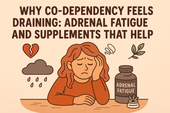
Why Co-Dependency Feels Draining: Adrenal Fatigue and Supplements That Help
The adrenal glands are small but powerful organs that sit above your kidneys, acting as your body’s built-in stress managers. They produce hormones like cortisol and adrenaline that help regulate energy, mood, and resilience. When they’re overworked from chronic stress or emotional exhaustion, fatigue and imbalance follow. Supporting adrenal health naturally can help restore calm, energy, and hormonal balance. 🌿⚡
-

The Link Between Anxiety, Co-Dependency, and Natural Support
Anxiety feels like living in constant alert mode—your heart races, your thoughts loop, and your body can’t find peace. It’s the nervous system’s way of preparing for danger, even when none exists. Understanding what’s happening in your mind and body is the first step toward calming the storm and restoring balance. 🌿💫
-
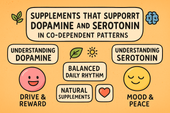
Supplements That Support Dopamine and Serotonin in Co-Dependent Patterns
Serotonin is the neurotransmitter of calm, confidence, and contentment. When it’s balanced, you feel peaceful and emotionally grounded. When it’s low, anxiety, mood swings, and emotional dependence take over. By understanding serotonin’s role in emotional health—and how to support it naturally—you can rebuild inner stability, improve relationships, and cultivate lasting happiness from within. 🌞💫
-

How Emotional Exhaustion in Codependency Impacts the Nervous System
The nervous system is the body’s communication network, connecting the brain to every organ and muscle. It regulates stress, mood, and emotion through a delicate balance of electrical and chemical signals. When overwhelmed, it can become dysregulated—leading to fatigue, anxiety, and emotional imbalance. Understanding how to calm and strengthen the nervous system is key to healing from chronic stress and emotional burnout. ⚡🌿
-
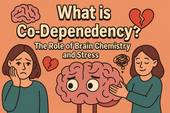
What Is Co-Dependency? The Role of Brain Chemistry and Stress
Stress is more than a feeling—it’s a full-body experience that begins in the brain and ripples through every cell. When cortisol surges and the nervous system stays on alert, your body can’t rest or recover. Over time, this constant tension affects energy, focus, mood, and even immune health. Understanding stress chemistry is the first step toward breaking free from burnout and finding calm again. 🌿
-

Creating a Supplement Stack for Motivation, Energy, and Anti-Procrastination
Motivation is the fuel behind every meaningful achievement—but it’s not just about willpower. It’s a mix of mindset, brain chemistry, and momentum. When energy, focus, and purpose align, action feels natural instead of forced. Learn how to harness motivation as a daily state, not a fleeting feeling.
-
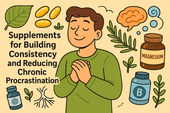
Supplements for Building Consistency and Reducing Chronic Procrastination
Biochemistry is the bridge between biology and chemistry—the science of life at the molecular level. It explains how nutrients, hormones, and neurotransmitters interact to create energy, thought, and emotion. From brain function to muscle movement, biochemistry reveals the invisible processes that sustain health, balance, and vitality.
-
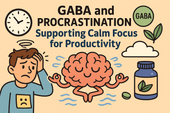
GABA and Procrastination: Supporting Calm Focus for Productivity
GABA is the brain’s natural calming messenger—a neurotransmitter that helps slow mental overactivity and ease stress. When GABA levels drop, focus fades, anxiety rises, and procrastination becomes more likely. By supporting GABA through nutrition, lifestyle, and supplements, you can restore calm clarity, improve focus, and take action with steady, balanced energy.
-
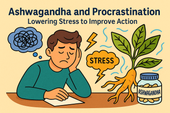
Ashwagandha and Procrastination: Lowering Stress to Improve Action
Science is the language of curiosity and discovery. It helps us understand the hidden patterns behind life, energy, and the universe. Through experimentation and critical thinking, science connects imagination to evidence—turning questions into knowledge. Whether through microscopes, molecules, or minds at work, science represents our endless pursuit of truth and innovation.
-

Neurotransmitters and Motivation: Supplements That Support Drive and Focus
Supplements can do more than boost physical health—they can also enhance mental clarity, focus, and motivation. Nutrients like omega-3s, magnesium, B vitamins, and adaptogens help balance neurotransmitters, stabilize mood, and support brain energy. When combined with good sleep, nutrition, and mindful habits, they can transform how your brain performs under stress.
-

How Stress Hormones Like Cortisol Fuel Procrastination (and What Helps)
Blood sugar isn’t just about physical health—it directly impacts focus, mood, and motivation. When glucose levels spike and crash, energy and attention do the same, fueling procrastination and brain fog. Learning how to stabilize blood sugar through balanced meals, mindful habits, and key nutrients helps keep your mind steady, focused, and ready to act.
-
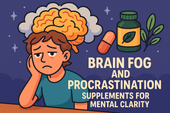
Brain Fog and Procrastination: Supplements for Mental Clarity
Brain fog can turn even simple tasks into mental hurdles. When your thoughts feel slow and unclear, procrastination often follows—making focus and productivity seem impossible. This article explores the biochemical and lifestyle causes of brain fog and reveals the most effective supplements for restoring mental clarity, focus, and sustained energy.
-

The Link Between Low Energy and Procrastination: Can Supplements Help?
Neurochemistry shapes how we think, feel, and act. When neurotransmitters like dopamine, serotonin, and GABA fall out of balance, it can lead to fatigue, anxiety, or lack of motivation—fueling procrastination and low mood. Understanding the brain’s chemical communication system helps us find ways to restore focus, calm, and emotional stability through nutrition, mindfulness, and targeted supplements.
-
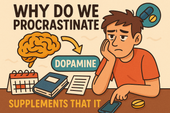
Why Do We Procrastinate? The Role of Dopamine and Supplements That Support It
Dopamine is the brain’s motivation messenger—the chemical that fuels focus, reward, and drive. When dopamine levels drop, even simple tasks can feel impossible to start. This article explores how dopamine shapes procrastination, motivation, and mental energy, along with natural supplements and daily habits that help restore balance and get things done.
-
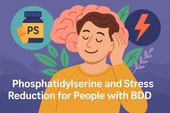
Phosphatidylserine and Stress Reduction for People with BDD
Stress is more than a mental state—it’s a full-body experience that affects hormones, brain chemistry, and emotional balance. For people with Body Dysmorphic Disorder (BDD), constant tension and worry about appearance can overload the nervous system. Learning how stress works and finding ways to calm it is key to breaking the cycle of anxiety and self-criticism.
-

How Antioxidants Like Vitamin C & E Support Mental Health in BDD
Antioxidants are the body’s natural defense against stress and inflammation. For people with Body Dysmorphic Disorder (BDD), oxidative stress can worsen fatigue, anxiety, and emotional imbalance. Nutrients like Vitamin C and E help protect brain cells, boost neurotransmitter function, and support a calmer, clearer mindset—building a stronger foundation for recovery.
-
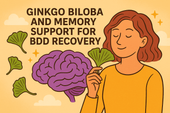
Ginkgo Biloba and Memory Support for BDD Recovery
Emotional regulation is the foundation of healing from Body Dysmorphic Disorder (BDD). When the nervous system stays in constant overdrive, even small stressors can trigger self-critical spirals. Learning to calm emotional reactivity helps restore clarity, confidence, and a sense of inner balance. By blending mindfulness, nervous system support, and self-compassion, you can retrain your brain to respond—not react—to emotion.
-
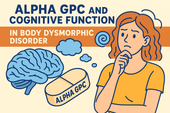
Alpha GPC and Cognitive Function in Body Dysmorphic Disorder
Mental fatigue can feel like your brain has hit a wall—thoughts slow down, focus fades, and motivation disappears. For people with Body Dysmorphic Disorder (BDD), chronic overthinking, emotional stress, and constant self-evaluation can deplete mental energy even further. Understanding what causes this cognitive exhaustion is the first step toward recovery—through rest, balanced nutrition, and targeted brain-supporting supplements.
-
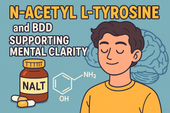
N-Acetyl L-Tyrosine and BDD: Supporting Mental Clarity
Chronic stress doesn’t just affect your mood—it reshapes your brain chemistry, weakens focus, and fuels the obsessive thought loops common in Body Dysmorphic Disorder (BDD). Over time, constant cortisol elevation drains mental energy and emotional balance. Learning to recognize and manage chronic stress is essential to restoring mental clarity, self-compassion, and resilience.
-

Chamomile and Lavender for Calming Obsessive Body Image Thoughts
The nervous system is the command center of our emotional and physical world—and in Body Dysmorphic Disorder (BDD), it often operates in overdrive. Understanding how the brain and body communicate under stress reveals why intrusive thoughts feel uncontrollable. Learning to regulate the nervous system through calm practices, nutrition, and supplements helps restore inner balance and emotional safety.
-
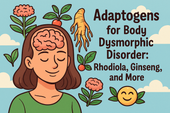
Adaptogens for Body Dysmorphic Disorder: Rhodiola, Ginseng, and More
Rhodiola rosea, often called the “golden root,” is an adaptogenic herb renowned for boosting stress resilience and mental endurance. For individuals with Body Dysmorphic Disorder (BDD), Rhodiola may help reduce fatigue, regulate cortisol, and enhance emotional balance. By supporting both mind and body, this powerful plant promotes calm focus, improved mood, and renewed energy to face daily challenges.
-
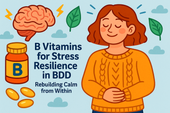
B Vitamins for Stress Resilience in BDD: Rebuilding Calm from Within
Biochemistry is at the heart of every thought, emotion, and reaction we experience. In Body Dysmorphic Disorder (BDD), chemical imbalances in neurotransmitters like serotonin, dopamine, and GABA can amplify stress and distort self-perception. Understanding the biochemistry behind mood and stress regulation offers a path toward healing—bridging the gap between emotional experience and the body’s molecular balance.
-
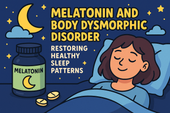
Melatonin and Body Dysmorphic Disorder: Restoring Healthy Sleep Patterns
Melatonin, the body’s natural sleep hormone, plays a vital role in helping people with Body Dysmorphic Disorder (BDD) restore healthy sleep cycles. When anxiety and obsessive thinking interfere with rest, melatonin levels often drop, leading to more emotional reactivity and distorted self-perception. This article explores how melatonin works, why BDD disrupts it, and how natural supplementation—combined with mindful routines—can help the brain and body finally find calm at night.
-
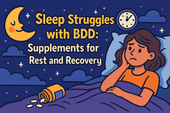
Sleep Struggles with BDD: Supplements for Rest and Recovery
When you’re living with Body Dysmorphic Disorder (BDD), restful sleep can feel impossible—but the right supplements can help reset your body’s natural rhythm. From magnesium and L-theanine to 5-HTP and ashwagandha, these nutrients support relaxation, lower cortisol, and enhance melatonin production. This article explores how supplements can calm the mind, ease nighttime anxiety, and promote true restorative sleep for emotional and physical recovery.
-
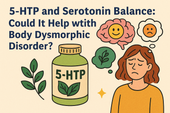
5-HTP and Serotonin Balance: Could It Help with Body Dysmorphic Disorder?
Anxiety can feel like a storm inside the mind—restless, overwhelming, and hard to control. In people with Body Dysmorphic Disorder (BDD), anxiety often fuels obsessive thoughts and self-criticism, creating a painful cycle of worry and self-doubt. This article explores the biological roots of anxiety, the role of neurotransmitters like serotonin and GABA, and how natural strategies such as mindfulness, supplements, and nervous system regulation can restore calm and mental clarity.
-
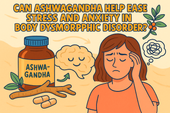
Can Ashwagandha Help Ease Stress and Anxiety in Body Dysmorphic Disorder?
Neurotransmitters like serotonin, dopamine, GABA, and acetylcholine are the chemical messengers that shape how we think, feel, and react to stress. In Body Dysmorphic Disorder (BDD), imbalances in these neurotransmitters can amplify anxiety, obsessive thinking, and emotional distress. This article explores how restoring healthy brain chemistry through nutrition, supplements, and mindfulness can help bring clarity, calm, and emotional stability.
-
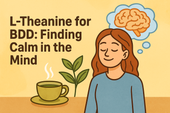
L-Theanine for BDD: Finding Calm in the Mind
Neurochemistry plays a central role in how we think, feel, and see ourselves. For those living with Body Dysmorphic Disorder (BDD), imbalances in neurotransmitters like serotonin, dopamine, and GABA can intensify anxiety, obsessive thoughts, and emotional distress. This article explores how regulating brain chemistry through supplements, mindfulness, and lifestyle changes can bring the nervous system back into harmony and restore inner calm.
-

Omega-3 Fatty Acids and Body Image Disorders: Supporting Emotional Health
Omega-3 fatty acids do far more than support heart health—they nourish the brain, stabilize mood, and may ease the emotional turbulence tied to body image disorders like BDD. This in-depth article explores how omega-3s regulate serotonin, dopamine, and inflammation, helping individuals reduce obsessive thoughts and rebuild self-acceptance. It also connects nutrition to therapy, mindfulness, and nervous system balance for holistic emotional healing.
-
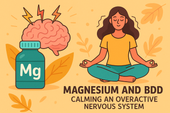
Magnesium and BDD: Calming an Overactive Nervous System
Magnesium plays a crucial role in calming an overactive nervous system—something people with Body Dysmorphic Disorder (BDD) struggle with daily. This article explores how magnesium supports relaxation, emotional regulation, and stress reduction while diving into the science behind its connection to brain chemistry. It also examines how combining magnesium supplementation with therapy and breathwork can help rebalance the body’s stress response, reduce obsessive thought patterns, and promote lasting nervous system calm.
-
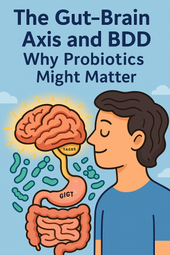
The Gut-Brain Axis and BDD: Why Probiotics Might Matter
The gut and brain are constantly in conversation — and that dialogue may shape how you experience Body Dysmorphic Disorder. By nurturing your microbiome with probiotics, prebiotics, and gut-healing nutrients, you can help rebalance serotonin, calm anxiety, and restore emotional stability from within 🧠🦠.
-
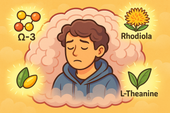
Brain Fog and Body Dysmorphic Disorder: Can Nootropic Supplements Help?
Brain fog often accompanies Body Dysmorphic Disorder, clouding focus and deepening emotional fatigue. Nootropic supplements like L-theanine, Rhodiola, and CoQ10 can help restore mental clarity, balance neurotransmitters, and bring calm energy back to the mind 🌿🧠.
-
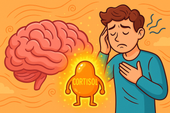
How Stress Hormones Like Cortisol May Worsen Body Dysmorphic Disorder
Chronic stress floods the brain with cortisol — the hormone that keeps you on high alert. In Body Dysmorphic Disorder, this chemical overdrive fuels anxiety, distorts self-image, and traps the body in survival mode. Calming cortisol helps restore both peace and perspective 🌿🧠.
-

What Is Body Dysmorphic Disorder? A Deeper Look at the Mind-Body Connection
Body Dysmorphic Disorder (BDD) isn’t just about appearance — it’s about perception. When brain chemistry, trauma, and stress distort self-image, the mind begins to see flaws that aren’t truly there. Healing starts by calming the nervous system and reconnecting mind and body 🪞🧠.
-
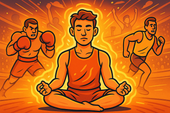
Keeping Calm in Competitive Sports: How to Train Your Mind, Body, and Chemistry for Peak Performance
Competitive pressure can overwhelm even the strongest athletes — but calm is trainable. By combining supplements like magnesium, L-theanine, and adaptogens with breathwork and mindset training, you can stay focused, balanced, and in control under any level of stress 🧠🏅.
-
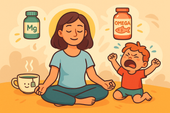
Supplements for Parents Facing Toddler Tantrums: Staying Calm When Little Emotions Run Wild
Toddler tantrums can drain even the most loving parent — but your calm is powerful. With the right supplements like magnesium, L-theanine, and ashwagandha supporting your nervous system, you can stay patient, grounded, and kind, even when emotions run high 🧸🌿.
-

Workplace Stress and Anger Management Support
Workplace stress can quickly turn into frustration — but calm is a skill you can train. By combining supplements like magnesium, L-theanine, and adaptogens with breathwork and mindset tools, you can stay focused, patient, and emotionally grounded no matter how intense the office gets 💼🌿.
-

How to Stay Patient With Family During Stressful Holidays
Holiday gatherings can stir up old stress and test your patience — but calm is possible. With nervous system support from magnesium, L-theanine, and adaptogens, plus mindful breathing and clear boundaries, you can stay centered, kind, and grounded even when family chaos unfolds 🎄💞.
-

Supplements to Keep Calm During Traffic Jams
Getting stuck in traffic doesn’t have to ruin your mood. With calming supplements like magnesium, L-theanine, and ashwagandha, you can train your body to stay relaxed and focused behind the wheel — turning gridlock into a moment of grounded patience 🚗🌿.
-
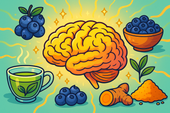
The Role of Antioxidants in Healing Brain Stress from Dissociation
Antioxidants protect the brain from the oxidative stress caused by trauma and dissociation. By neutralizing free radicals and supporting mitochondrial recovery, they help restore clarity, focus, and emotional balance — allowing the mind to heal at the cellular level 🌿🧠.
-
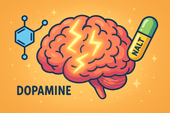
N-Acetyl L-Tyrosine (NALT) for Supporting Mental Clarity
N-Acetyl L-Tyrosine (NALT) fuels dopamine production — the neurotransmitter of focus and motivation. By supporting brain chemistry during stress, NALT helps restore mental clarity, energy, and alertness, making it easier to think clearly and feel present again ⚡🧠.
-

How Ginseng May Improve Focus and Energy in Dissociation
Ginseng helps combat the mental fatigue and fog that often come with dissociation. By supporting mitochondrial energy, balancing neurotransmitters, and regulating cortisol, it gently restores focus, motivation, and emotional presence — helping the mind reconnect with clarity and strength 🌿⚡.
-
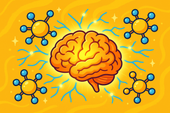
Phosphatidylserine and Dissociation: Supporting Cognitive Function
Phosphatidylserine helps calm the stress response by balancing cortisol, the body’s primary stress hormone. By lowering cortisol spikes, it protects memory, focus, and emotional stability — restoring clarity and mental presence for those struggling with dissociation 🧠🌿.
-
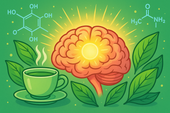
Can Green Tea Extract Help with Dissociative Brain Fog?
Green tea extract may help lift dissociative brain fog by supporting neurotransmitter balance, reducing inflammation, and enhancing energy at the cellular level. With its key compounds EGCG and L-theanine, it promotes calm focus, clarity, and emotional presence — helping you feel more alert and grounded 🍵🧠.
-
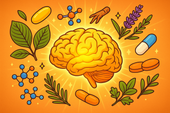
Building a Natural Supplement Stack for Dissociation Support
Building a supplement stack for dissociation means nourishing the brain and body back into communication. By supporting neurotransmitters, gut health, and energy balance through nutrients like magnesium, omega-3s, curcumin, and probiotics, you can help restore clarity, calm, and connection — one layer at a time 🌿🧠.
-

Chamomile and Lavender for Dissociative Anxiety Relief
Chamomile and lavender work together to calm dissociative anxiety by soothing the nervous system and restoring emotional safety. Their natural compounds balance cortisol, enhance GABA activity, and activate the vagus nerve — helping you feel grounded, connected, and at peace again 🌿💜.
-
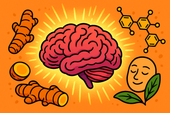
Curcumin for Inflammation and Mental Clarity in Dissociation
Curcumin, the golden compound in turmeric, does more than fight inflammation — it helps clear the mental fog often tied to dissociation. By calming neuroinflammation, balancing neurotransmitters, and supporting mitochondrial energy, curcumin can restore mental clarity, focus, and emotional presence 🌿🧠.
-
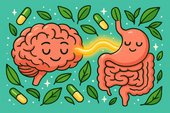
Probiotics and Dissociation: Exploring the Gut–Brain Axis
The gut–brain axis plays a vital role in emotional awareness and presence. When the microbiome is balanced, it supports serotonin production, vagus nerve activity, and calm focus. Probiotics help repair this connection — restoring safety, clarity, and the feeling of truly being in your body again 🌿🧠.
-
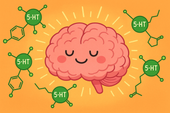
5-HTP for Dissociation: Supporting Serotonin and Emotional Stability
5-HTP helps bridge the gap between emotional numbness and stability by supporting serotonin production — the neurotransmitter that shapes mood, sleep, and sensory awareness. For people experiencing dissociation, 5-HTP may gently restore connection, presence, and emotional balance from the inside out 🌿🧠.
-
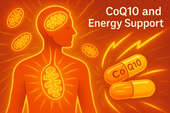
CoQ10 and Energy Support for People with Dissociation
Chronic dissociation often leaves the body running on empty — tired, foggy, and disconnected. CoQ10 helps recharge that system at the cellular level by restoring mitochondrial energy, reducing oxidative stress, and supporting the brain’s capacity to stay present. It’s energy medicine for both body and mind ⚡🧠.
